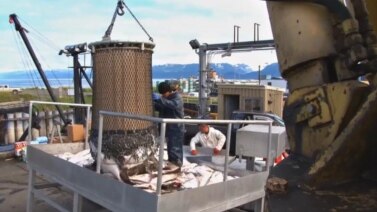Fishing, climate change and pollution threaten many shark species. Now, scientists are getting a close look at the shark environment. They want to better understand the threats this important animal faces.
The University of Hawaii research site is on Coconut Island in Hawaii. It is just minutes by motorboat from the shore of Oahu, the most populated of the Hawaiian Islands. The facility is a good place to observe sharks, since they are native to local waters. Some are being kept in this sheltered bay for study.
Carl Meyer researches shark behavior.
"...when sharks are feeding and hopefully how much they're eating. And that's what we use these captive animals for."
Scientists also observe the behavior of sharks in the open ocean. They place a sensor device in their food to observe the digestion process. They also measure the animals. Then the researchers release the sharks with electronic tracking devices attached to their fins.
The researchers study tiger sharks, sandbar sharks, blacktip sharks and many others. They recently attached a camera to a sandbar shark to record its everyday activities.
"And when we recovered the camera, we saw that the shark had spent the day in a large aggregation of sharks, not just sandbar sharks but also blacktip sharks and many, many scalloped hammerhead sharks."
Sharks are quick and deadly but rarely attack humans.
Carl Meyer says those rare attacks receive heavy media coverage and are dramatized in movies like 1975’s “Jaws.”
He says sharks are important top-level hunters. They help keep a balance in ocean ecosystems. Pollution, climate change and fishing threaten those systems.
Many fishermen target sharks for the Asian food market. Fishermen also sometimes kill sharks in the process of hunting other species.
The scientists at University of Hawaii study endangered sharks and those at risk of endangerment.
Carl Meyer says that humans are more of a risk to sharks than sharks are a risk to humans.
"Because never before in the natural history of the world have we seen a species become so dominant and so able to alter the natural environment."
And he says the results of those environmental changes cannot always be predicted.
I’m Marsha James.
VOA Correspondent Mike O’Sullivan reported this story from Honolulu, Hawaii. Marsha James wrote it for Learning English. Caty Weaver was the editor.
Words in This Story
bay – n. a large area of water that is part of an ocean or lake and partly surrounded by land
sensor – n. a device that detects or senses heat, light, sound, motion, etc., and then reacts to it in a particular way
aggregation – n. a group
endangered – adj. used to describe a type of animal or plant that has become very rare and that could die out completely
dominant – adj. more important, powerful, or successful than most or all others
alter – v. to change (something)

